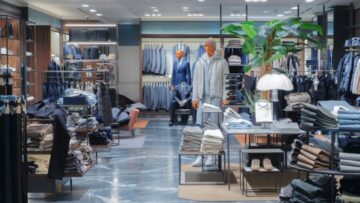
We have entered an era of ‘Digital Darwinism’, which is not a fad but a full-blown disruption, and the retailer that keeps up with the fast pace and rapid changes for its customers will win the race. Indians are over the pandemic blues, sales are up and recovery is underway.
Retail: Growth engine of the Indian economy
According to the IBEF Retail report, “Indian retail has become one of the most dynamic and fast-moving industries with the entry of several new players. It accounts for more than 10 per cent of the country’s gross domestic product (GDP) and around 8 per cent of employment. India is the world’s fifth-largest retail destination country.”
There are several factors that are driving the growth of fashion retail in India and will continue to be a major catalyst in the future. The rise of the internet, smartphone penetration and growing adoption of digital payment systems in Tier-2 and Tier-3 are also some of the key market drivers. Indeed, India will be the centre of attraction for international brands as well.
Below are some observations from McKinsey, Business Insider, Kearney Research and data on Indian consumer behaviour that point to great potential in the large Indian consumer market:
- India will have the third largest number of high-income households by 2030, a growing class with greater disposable income
- The younger generation, aged 18 to 25, are becoming increasingly fashion-conscious, and the number of online shoppers in India is expected to reach 500 million by 2030
- Rurbanisation and Urbanisation will increase market demand, per capita consumption in rural areas will increase 4.3 times by 2030, compared to 3.5 times in urban areas – a thriving area for remarkable growth
- India will add nearly 90 million new households headed by millennials born in liberalised India. The country’s median age will be 29 by 2025, and by then, the country will have the world’s largest pool of skilled labour of over 600 million
- India’s retail industry is expected to grow by more than US $ 1.8 trillion by 2030
- About 12,500 retailers are expected to be added and nearly 30 million jobs are expected to be created in India by 2025
- Transition from need-based to demand-based shopping will be pushed
India: Promising market for fashion retailers
Fashion retail is a significant sector in India, with estimated sales of US $ 88 billion. India is home to some of the world’s leading fashion companies with substantial profits, such as Arvind Group, Madura Fashion and Lifestyle, Raymond Apparel, Trent Retail, Reliance Retail and Future Group, which have launched their own fashion labels to add new customers, especially in the traditional and Indo-Western markets. Not only the private labels but designer labels are in the race and flourishing too. Some designers like Sabyasachi Mukherjee, Masaba Gupta, Manish Malhotra are collaborating with the fashion retail giants and acquiring customer loyalty.
- Arvind Group, Madura Fashion and Lifestyle, Raymond Apparel, Trent Retail, Reliance Retail and Future Group launched their own labels
However, the model that is catching everyone’s attention is direct-to-consumer (D2C). Sports brand PUMA has launched its mobile shopping app in India. Catering to the country’s growing cohort of fashion-forward online shoppers and increased adoption of D2C channels, India is the first market to have access to the app developed by PUMA. A consumer-friendly interface built especially for the Indian market, the PUMA app will offer the brand’s latest drops, apparel and gear with features such as quick login, efficient check-out and secure digital payments.
Abhishek Ganguly, MD, PUMA India and Southeast Asia said, “The launch of the app is a decisive and a clear endorsement of our efforts to build and scale D2C channel via the digital route. We aim to bolster our offerings and services to our consumers in the most seamless way, and the app is a step in that direction.”
Launched by ABFRL, TMRW focuses on India’s largest portfolio of breakthrough brands in the fashion and lifestyle market that is driving the next phase of D2C in fashion, beauty and related lifestyle areas. The retailer will provide comprehensive services to the domestic brands, including planning, promotion, cataloguing, logistics, quality control and mentoring. Globalbees, Mensa Brands (India’s fastest unicorn), Powerhouse 91 and 10 Club are amongst the companies in the country pursuing a similar business strategy.
- Globalbees, Mensa Brands (India’s fastest unicorn), Powerhouse 91 and 10 Club are promoting D2C concept
Ashish Dikshit, MD of ABFRL said, “ The formal launch of our D2C business, TMRW, is a key milestone for the company. This venture has the potential to become a significant growth engine by tapping into the new wave of entrepreneurial energy in India. Our aspiration is to build a portfolio of 30+ brands in the next 3 years. With the launch of this venture, we intend to double down on our ongoing programme of strategically attracting new pools of capital that are seeking investment in high-growth businesses. We are confident that this foray will successfully meet the aspirations of digitally native consumers and also create long-term value for investors and other stakeholders.”
As the fashion industry offers the greatest opportunity of all D2C industries, this has led to an explosion of D2C fashion companies in India. Of all the D2C segments in India, this sector has raised the highest amount of funding at US $ 756 million+ (between 2014 and 2021). Fashion brands such as Bewakoof, 20Dresses, Chumbak, Jaipur Kurti, Bombay Trooper, Creatures of Habit, Anouk, Fable Street, The Souled Store, Wrogn, The Pant Company, FabAlley, Zivame, Clovia, Pretty Secrets, Bombay Shirt Company and Andaman, to name a few, have relied on social media and commerce to gain traction and have now become true brands.
- Bewakoof, 20Dresses, Chumbak, Jaipur Kurti, Bombay Trooper, Creatures of Habit, Anouk, Fable Street, The Souled Store, Wrogn, The Pant Company, FabAlley, Zivame, Clovia, Pretty Secrets, Bombay Shirt Company and Andaman
The growth of digital infrastructure and widespread adoption of D2C brands, especially in Tier-2 and Tier-3 cities, seems to be the most significant development in recent years, openly heralding the future of the billion-dollar model. More than 600 brands have been launched in India since 2016, and market growth suggests that the industry could reach US $ 106 billion by 2025. D2C is more than just a distribution channel; the insights can help companies develop market strategies, dive into the innovation pool and test their products in the market before the big launch. Fashion giants have recognised this importance and are therefore becoming ‘Houses of Brands’.
According to the Inc24 analysis report, the apparel and footwear segment is expected to control nearly 77.1 per cent of the total D2C fashion market by 2025. Sustainability, technology integration (AI, AR /VR, ML and more), increasing personalisation, omnichannel business model, promotion of social awareness and use of influencer and content marketing are some of the current trends amongst fashion D2C companies in India. Social commerce adoption is also an indicator as emerging platforms like Trell, Moj, Josh, and others are attracting millions of users from Tier-2 and Tier-3 cities and towns.
Some young domestic brands like Karagiri, Jaipur Kurti, Radhka, Handme, Ethnos, March etc., are the emerging names of the industry in 2022. The industry is expected to grow significantly in the coming years, providing opportunities for entrepreneurs and investors. International brands like Uniqlo (6 stores), H&M (50 stores), Zara (21 stores), Marks & Spencer (94 stores), Guess (50), Asics (18) amongst 20 others are playing along and experiencing extremely good sales growth.
- Karagiri, Jaipur Kurti, Radhka, Handme, Ethnos, March are young emerging brands
- Uniqlo (6 stores), H&M (50 stores), Zara (21 stores), Marks & Spencer (94 stores), Guess (50), Asics (18), Triumph International (20)amongst 20 other international brands are on an expansion spree
Kearney’s analysis based on demographic potential, e-commerce penetration, appetite for branded apparel and digital awareness clearly shows that cities beyond the top 20 will drive India’s next retail growth. As the brands are on a store opening spree, this growth will continue to happen. Barcelona (200), Dollar Industries (125), 1-India Family Mart (100), Popees (100), Guess (50), Tasva (50), The Souled Store (50), Fabindia (30), Saundh (25), Triumph International (20) are the ones with most recent store opening announcements in India.
- Barcelona (200), Dollar Industries (125), 1-India Family Mart (100), Popees (100), Tasva (50), The Souled Store (50), FabIndia (30) and Saundh (25)
Future Predictions
Future Stores: Bricks-and-mortar retail will no longer focus primarily on selling products as consumers increasingly look for experiences associated with purchases. Stores will need to engage in strong storytelling and rethink the entire shopping experience to be absolutely innovative for the customer. The next five years will change the way people visit stores. It’s about providing a personalised experience that is both contemporary and distinctive. The ‘store of the future’ will unite new trends in retail, including contactless checkouts, dynamic pricing systems and exclusive person-to-person special offers. Despite the rise of online retail, the role of the physical store will remain important. For example, realme opened its first global flagship store in Ahmedabad in partnership with Poojara Telecom, covering 13,000 square feet to provide customers with a luxurious, customised and innovative offline experience – a stunning technological experience in one floor (II) and an ideal model that gives a concise overview of how retail will evolve in the next 5-10 years, proving that ‘customers need a change and online services alone do not satisfy curiosity’.
VR & AI – Virtual Reality (VR) is already being used by some fashion retailers to give customers a realistic impression of how a garment would look on them. This technology will become more and more prevalent in the future. Dressing rooms equipped with VR headsets will become the norm, and we can expect to see more use of artificial intelligence (AI) and robotics in fashion retail, from helping customers find the right items to automated inventory management. This will help improve in-store efficiency and accuracy, and free up staff to provide a better experience for customers.
Uniqueness and Sustainability: Personalisation will be critical as consumers become more aware of the vast choices available to them and expect a personalised shopping experience. Thanks to data analytics, retailers will be able to offer personalised shopping experiences that are specifically tailored to customers’ individual preferences. This can range from recommendations to deals, coupons and promotions to styling and recommendations. Ultimately, we will likely see a shift towards sustainable and ethical fashion. As consumers slowly educate themselves and move to a ‘waste-free lifestyle’, we are excited to see a big shift in choices. In the coming years, we expect to see more sustainable materials, fair labour conditions, loaner clothing and transparency in fashion retail. Fast fashion retailers have, reportedly, seen a decline in customer purchases as consumers increasingly choose companies that are committed to the environment. As a result, demand for sustainable fashion brands has increased.
Smartphone Technology and Mobile Commerce: Smartphone technology already enables the creation of digital experiences in physical space – it is used to create animated content when displaying codes or links on QR. Customers are using their mobile devices to engage with items and make purchases. A similar trend will emerge across the country over the next five years. There is also a slowly evolving but promising model that is creating buzz amongst customers because of its convenience: ‘mobile commerce’. However, mobile commerce is more than just an extension of e-commerce. It is already huge, and will only get bigger in India.
In addition to UPI, mobile wallets, Digital India Makeover, etc., the country’s Prime Minister has strongly supported and encouraged digital transactions through the use of mobile banking and e-banking for cashless purchases. The debut of the BHIM app, which promotes digital transactions directly through banks using UPI, is an example of this approach. This is a clear indication of the emerging trend in urban India. More and more consumers are using their smartphones to do everything from research to shopping. Brands need to ensure their mobile experience is top-notch if they want to stay ahead of the curve.
Omnipresent Model: It’s been realised that offline and online are two very important areas. They do not compete with each other, they complement each other. Creating an omnichannel presence is extremely important for a brand’s visibility. Soon, customers will find the offline stores of all their favourite online brands under one roof. With an omnichannel presence, they will have more options and ways to stay connected.
Today’s hyper-connected Indians expect brand owners to provide consistent and exceptional service across all touch-points. They are not only looking for the right products to suit their needs, but also a seamless process in identifying the product, buying it and getting it delivered to their homes. Fashion retailers should never limit themselves to a single platform but should leverage all channels to reduce customer bounce rates. Amazon, Shoppers Stop and Mensa Brands, along with 50+ brands, are investing in analytics to improve the customer experience by collecting offline and online generated data. This information is used to create a digital customer experience both in their stores and on their websites.
Mitigating the Challenges
With a population of more than 1.38 billion people, India has a wide range of cultures, geographies and regional trends, driving heterogeneity in the Indian retail market. This is causing retailers to look for local efficiencies in their business approach. Further complicating matters, consumer groups in these diverse markets are constantly changing due to increasing exposure to fashion trends and rising income levels.

It’s no secret that fashion retailers are currently facing significant challenges.
● Sustainability will be of paramount importance. As consumers become more aware of the environmental and social impact of their clothing choices, sustainability will become an increasingly important factor in purchasing decisions. Retailers that can offer sustainable options will gain a competitive advantage.
● The customer journey is already largely digital, but it will become more so in the future. Customers will increasingly use their smartphones and other devices to research brands and products, compare prices and make purchases. Retailers need to ensure they provide a seamless and convenient digital experience.
● The rise of fast fashion has been one of the biggest challenges for traditional retailers in recent years. However, as consumers become more aware of the environmental and social impact of cheap clothing, there may be a greater shift towards biannual shopping.
● Indian fashion retail suffers from infrastructural bottlenecks caused by inadequate roads, highways and other infrastructure conditions, which create supply chain constraints and increase lead time, inventory carrying costs and warehousing costs. India still has much room for development of basic infrastructure, such as the quality of roads, ports and energy supply.
● Online shopping currently accounts for only 2 per cent of total retail sales in India, but is expected to increase to 10 per cent by 2027. This poses a major challenge for bricks-and-mortar retail, which must find ways to compete with online retail.
● The Indian retail sector is highly fragmented, with a large number of small ‘mom-and-pop’ stores. However, there are some large national retailers that are beginning to make inroads.
● The core issues of the retail experience are pay and checkout, whether offline or online. There is a lot of scope for better seamless procedures.
Government policy: An important catalyst
For international brands and retailers, India is becoming a high-priority market. With slower growth in their home countries, retailers are looking to expand globally and will vie for share in the Indian market. The international brands will enable the establishment of strong domestic brands that will benefit from their supply chains and expertise in local retail dynamics.
Experts predict the future of fashion retail may see an imbalance between larger and smaller players in the industry. This means that the largest players will become even larger and smaller retailers will have a hard time competing. To keep the smaller retailers from leaving, the Indian Government is pursuing policies that benefit everyone. It has taken various initiatives to improve the retail industry in India. Some of them are listed below
- Access to Credit: The Pradhan Mantri Mudra Yojana (PMMY) has made it easier for entrepreneurs and small businesses, including traders and retailers, to obtain business and working capital loans without collateral and processing fees.
- Multifunctional Warehouses: Replacing indirect taxes with a goods and services tax (GST) was an important step in optimising the supply chain. The Government has outlined a strategy to establish multifunctional logistics parks to improve operational efficiency and enable retailers to reduce operating costs while offering customers greater choice.
- Modernisation through Technology: The Digital India programme supports the establishment of platforms that promote online delivery of Government services while raising public awareness. The BHIM and UPI AutoPay applications have accelerated the adoption of digital payments by offering users speed, security and reliability.
- Tax: Reducing the corporate tax rate for retailers and e-commerce players in the consumer market sector: At GOI, the corporate tax rate for new Indian manufacturing companies has been reduced to 15 per cent, provided they begin operations on or before 31 March 2023. In addition, the lower tax rate must be extended to e-commerce as it complements manufacturing activity.
- A boost for entrepreneurship: Start-up India aims to build a strong start-up ecosystem by encouraging entrepreneurs to register and benefit from tax holidays and other incentives. In 2021, the exemption limit for paying GST was Rs.40 lakh, which was a big relief for small retailers.
- FDI Push: Uniqlo is an example of a success story that began in 2019 with its single-brand direct investment in India and soon turned the tide in the ecosystem. Tomohiko Sei, Chief Executive Officer of Uniqlo, is planning a 360-degree e-commerce solution based on the traditional shop-to-home concept. Foreign direct investment (FDI) has encouraged global brands to set up shop in India as the country has a bright future with rising internet penetration and higher disposable incomes.
According to experts, allowing foreign retailers to open online stores would not only promote healthy competition but also lead to job creation in areas such as logistics, digital payments, customer service and skills development. International capital continues to flow into the country due to the Indian Government’s favourable policy framework and thriving economic climate.
Our fashion retail market is catching up fast with global numbers. The fashion e-commerce market in India, currently worth US $ 8 billion to US $ 10 billion, can grow at a rate of 35 per cent and reach about US $ 30 billion in the next five years. The statistics clearly show that companies need to take advantage of emerging trends and work with them. The customer acquisition seems exciting and full of strategies that include technology, powerful (customer experience) Cx, a customer-centric approach, hyper-personalisation and a sustainable, seamless supply chain while keeping an eye on other pandemic-like situations.
Orbit of Scope
A variety of scenarios could emerge and turn the table but we need to wait for a couple of years to find out the direction of the market as Indian customers hold a big take in retailers’ decision-making. There are two scenarios that may or may not be considered as FAD but can kickstart a whole new dimension of how the clothing industry will work:
Scenario 1: Everything customised: Retailers will increasingly offer their customers personalised clothing tailored to their exact body measurements and style preferences. Many items will be made to order, personalised for a small fee, and delivered within a few days. As a result, retailers will have to spend less on inventory, and clearance discounts will be smaller.
Scenario 2: Preloved clothing: Product customisation will remain a niche in this scenario, while alternative methods of commerce will become prevalent. These alternative models could emerge. Consumers will be able to consume clothing the way they want – for an hour, a day or a week. They may even rent or sell items from their closet to people of similar sizes.
Which of the scenarios is most likely to occur soon? We can’t be sure, but we can look for ‘signals’ to see if the personalisation of products and/or alternative models for buying and wearing clothes will prevail. Time will tell or rather say ‘data will tell’.
Scenario 3: Smart textiles: With a number of companies showing up in Smart Textile/Clothing segment in India, the growth is inevitable in coming years.Smart Textile is being in use in medical textiles, athleisure/activewear/sportswear and even in fashion products. Right from monitoring body vitals, helping patients to cater to fashion statement of the millennials in India, the Smart Textile concept is just creating growth opportunities for the early starters.






